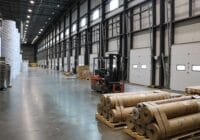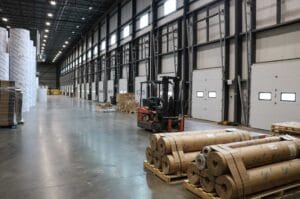If you work in supply chain management, shipping, or retail, you’ve probably heard the terms logistics and distribution used frequently. Sometimes, they seem interchangeable, but understanding the difference is crucial to optimizing your business processes.
Both logistics and distribution are essential components of moving products from manufacturers to customers, but they focus on different stages and activities within the supply chain.
In this article, we’ll explain what logistics and distribution mean, how they differ, and why both are vital for a smooth supply chain.
What Is Logistics?
Logistics refers to the overall management of the flow of goods, services, and information from the point of origin to the final customer. It covers a wide range of activities designed to ensure that the right products reach the right place at the right time, in the right quantity and condition.
Key Functions of Logistics:
- Transportation management: Selecting and managing carriers to move goods via road, rail, air, or sea
- Inventory management: Tracking and controlling stock levels to meet demand without overstocking
- Warehousing: Receiving, storing, and handling goods in warehouses or distribution centers
- Order fulfillment: Processing orders, picking, packing, and preparing shipments
- Supply chain coordination: Synchronizing suppliers, manufacturers, warehouses, and retailers
- Reverse logistics: Managing returns, recycling, and disposal of goods
Logistics involves planning, implementing, and controlling the efficient movement and storage of goods throughout the supply chain.
What Is Distribution?
Distribution is a subset of logistics focused specifically on the movement of finished goods from a warehouse or manufacturing facility to the end customer or retailer.
Distribution centers act as hubs where products are stored and then dispatched to fulfill customer orders. Distribution is primarily concerned with:
- Order processing: Receiving and managing orders from customers or retailers
- Inventory allocation: Deciding which warehouses or centers will supply specific orders
- Packaging and labeling: Preparing goods for shipment in accordance with customer requirements
- Shipping and delivery: Selecting carriers and managing last-mile delivery
- Customer service: Handling inquiries, tracking shipments, and managing returns related to distribution
Key Differences Between Logistics and Distribution
| Aspect | Logistics | Distribution |
| Scope | Broad; encompasses entire supply chain | Narrower; focuses on delivery to customer |
| Focus | Planning, implementation, and control of goods movement and storage | Moving finished goods from warehouses to customers |
| Activities | Transportation, warehousing, inventory management, order fulfillment, reverse logistics | Order processing, shipping, last-mile delivery, packaging |
| Goal | Optimize overall supply chain efficiency | Ensure timely, accurate delivery to customers |
| Includes | Distribution as a component | Does not include upstream logistics activities like procurement or inbound transport |
How Logistics and Distribution Work Together
Think of logistics as the umbrella term covering all activities required to manage the flow of goods from raw materials to finished products reaching consumers.
Distribution is the final stage in the logistics process, where finished products are picked, packed, and shipped to customers or retailers.
For example:
- A logistics team manages procurement of raw materials, production schedules, warehousing, and transportation across the supply chain.
- The distribution team handles processing customer orders, shipping products from distribution centers, and managing deliveries and returns.
Both teams must coordinate closely for customer satisfaction and cost efficiency.
Why Businesses Should Understand This Difference
Understanding the difference between logistics and distribution helps businesses:
- Improve operational efficiency by clearly defining responsibilities
- Reduce costs by optimizing transportation, storage, and delivery processes
- Enhance customer satisfaction with faster and more reliable deliveries
- Plan better for growth by scaling logistics or distribution as needed
For example, a company expanding into new markets might invest in new distribution centers without overhauling their entire logistics system.
Also Read: Distribution Models in Supply Chain
Common Challenges in Logistics vs Distribution
Logistics Challenges:
- Complex coordination across suppliers, warehouses, and carriers
- Managing inventory accuracy and avoiding stockouts or excess inventory
- Handling returns and reverse logistics efficiently
- Adapting to disruptions in transport or supply chain delays
Distribution Challenges:
- Meeting delivery deadlines and managing last-mile delivery costs
- Packaging goods properly for different shipping methods
- Handling order accuracy and tracking shipments
- Managing customer returns smoothly
Technology’s Role in Logistics and Distribution
Modern software solutions help businesses optimize both logistics and distribution:
- Warehouse Management Systems (WMS): Manage inventory, picking, and packing
- Transportation Management Systems (TMS): Optimize shipping routes, carrier selection, and freight costs
- Order Management Systems (OMS): Streamline order processing and fulfillment
- Inventory Management Software: Track stock levels and forecast demand
- Last-Mile Delivery Platforms: Improve customer delivery experience and tracking
Investing in the right technology can bridge logistics and distribution effectively, reducing errors and improving visibility.
Also Read: Distribution Center vs Warehouse
Conclusion: Logistics vs Distribution
While logistics covers the entire supply chain flow—from raw materials to final delivery—distribution specifically focuses on delivering finished products to the customer.
Both functions are vital. Logistics ensures the right products are available in the right place at the right time. Distribution guarantees those products reach customers efficiently and reliably.
By understanding the difference, businesses can better allocate resources, improve operations, and satisfy customers.
FAQs
1. Is distribution part of logistics?
Yes, distribution is a key component within the broader logistics process.
2. Can a company have distribution without logistics?
Distribution generally requires logistics support, but in some small businesses, distribution might happen with minimal logistics planning.
3. What skills are needed for logistics vs distribution roles?
Logistics roles often require planning and coordination skills, while distribution roles focus more on execution and customer service.
4. How does last-mile delivery relate to distribution?
Last-mile delivery is a critical part of distribution, involving the final delivery of goods to customers.
5. What industries rely heavily on logistics and distribution?
Retail, manufacturing, e-commerce, food and beverage, and pharmaceuticals are some examples.
6. What software can help manage logistics and distribution?
Warehouse Management Systems (WMS), Transportation Management Systems (TMS), and Order Management Systems (OMS) are popular solutions.



